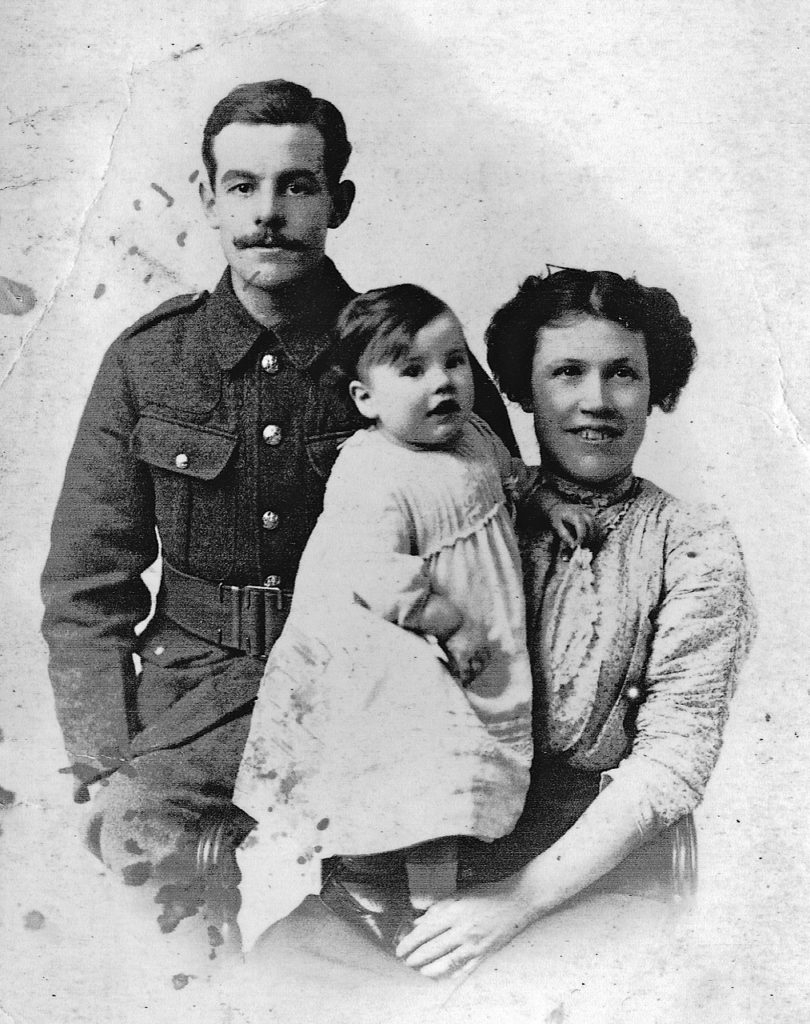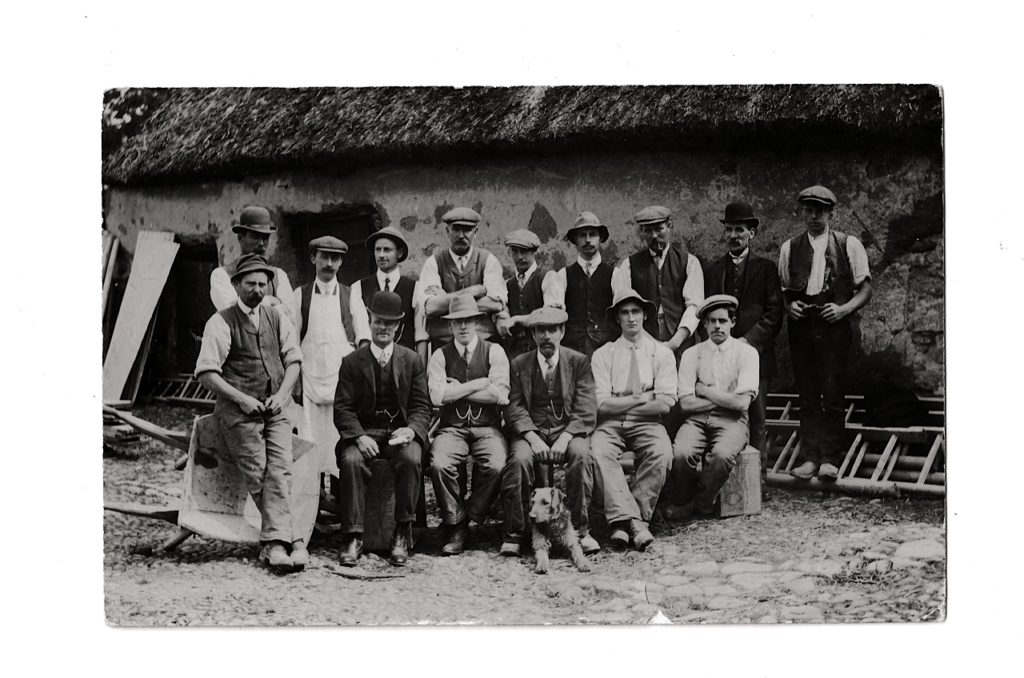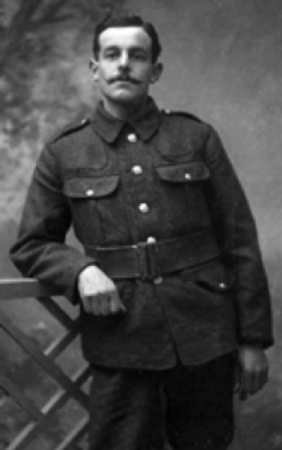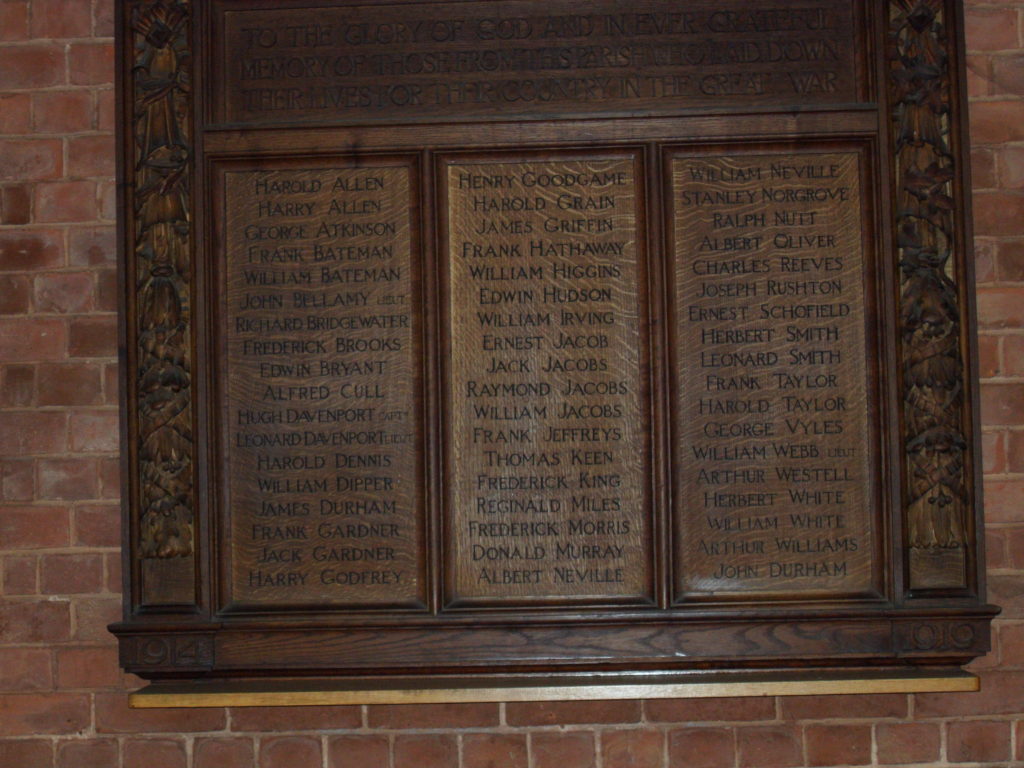Fact file:
College employee: Bricklayer, later stonemason, 1911-1916
Born: 12 June 1889
Died: 7 February 1916
Regiment: Royal Engineers
Grave/Memorial: Mazingarbe Communal Cemetery: no. 13
Family background
b. 12 June 1889 at 48, Highfield (90, Lime Walk since c.1920), Highfield, New Headington, Oxford, as the eldest son (of six children) of William Jacobs (1862–1929) and Eliza Ann Jacobs (née Adams) (1862–1949) (m. 1888). He was baptized at St Andrew’s Church, Old Headington, on 11 July 1889. At the time of the 1901 Census, the family were still living at 48, Lime Walk.
Parents and antecedents
Jacobs’s father, who was born in Headington, was also a stonemason and is recorded as living there in 1871 and 1881. For a time he worked in Bromsgrove but had returned to Headington by 1891 at the latest.
Jacobs’s mother was the fourth daughter (youngest of nine children) of a Headington butcher, Samuel Levi Adams (c.1820–73), who is described in the 1851 Census as a “Journeyman Pork Butcher” and whose given names, despite his erstwhile trade, may suggest a remote Jewish ancestry. In the 1880s, she worked from home as a pupil teacher. Samuel Levi and his wife Ann (née Horn) (c.1823–1907) (m. 1841) had had all their nine children by the time of the 1871 Census, including Jacobs’s mother Eliza Ann and her older sister, Emma Jane (1860–1939), who was the mother of Cyril Levett and thus Raymond’s aunt.
All the Jacobs siblings were baptized at St Andrew’s Church, Old Headington, to the north of the Oxford–London road, and it was here that they seem to have worshipped until the construction in 1910 of All Saints Church, in Highfield, Headington, to the south of the Oxford–London road. Many of the Adams family were baptized at St Andrew’s; Samuel Levi is buried in the churchyard; and Emma Jane and Eliza Ann were married there.
Siblings and their families
Brother of:
(1) Millicent (1890–1965 [Los Angeles]); later Cox after her marriage in 1912 to William George Cox (1890–1964), after which she lived permanently in North America; one daughter;
(2) Ernest (1892–1969), who married (1920) Rose Hodder (b.1897, date of death unknown); one daughter;
(3) Andrew (1894–1946), who married (1921) Ethel May Fordree (née Slater, 1892–1971); two sons, two daughters;
(4) Lewis (1897–98);
(5) Gladys Holton (1901–28); also Holton after her marriage in 1926 to Reginald Holton (1901–69).
On 25 August 1912, three days after their wedding, Millicent and William moved to Toronto, Canada, but in 1922 they emigrated to Los Angeles, California, USA. Their one daughter, Roberta Mae (“Bobbie”) Cox (b. 1929 in Los Angeles, date of death unknown), married [i] (1953) Howard Ernest French (1928–95) (marriage dissolved in 1971); and [ii] (1975) Gordon Ralph Laidlow (1923–99) in Norfolk, Great Britain, separated a few years later, and returned to Los Angeles, where she worked as a legal secretary until she was injured in a road accident at the age of 85.
Ernest married Rose Hodder in Lewisham on 2 June 1920, and in September 1922 he sailed from London to China in order to take up a senior post as an electrical engineer with the Shanghai Power Company at the Shanghai Power Station. Rose followed him in February 1923 and their daughter, Beryl Jacobs, was born there in c.1924. During World War Two they were all interned by the Japanese and after the war they moved to Australia (New South Wales), where Ernest resumed his trade as an electrical engineer.
Andrew began his working life as a building labourer but seems to have prospered, since in later life he described himself as a building contractor. After his marriage on 21 August 1921 at St Benet’s Church, Stepney, London E1, he and his wife, Ethel May, lived at 56, High Street, Poplar, London E14, until c.1926. As their three younger children were born in Poplar (1924), Romford, South-west Essex (1927), and Dagenham, South-west Essex (1933), the family probably moved to Headington in the mid-1930s, where they lived at 24, Stapleton Rd, off Old Rd, Headington.
Ethel May was born on 23 June 1892 at 25, Norah St, Stepney, London E2, as the daughter of Stephen Slater (1857–1925), a painter/labourer from Bethnal Green, and she married first Thomas George Fordree (1893–1921), a compositor, on 3 June 1913. Thomas George joined the Army on 1 September 1914 and was assigned to the Machine Gun Corps. But he was wounded on 20 November 1917 by a gun-shot wound to the spine, never really recovered, and died on 5 April 1921 at the National Hospital (for Paralysis), Queen’s Square, Holborn, which had been taken over by the military authorities. Their one child, Dora E. Jacobs (b. 1921, date of death unknown), was born in Bethnal Green on 1 September 1921. Ethel died in Dagenham, Essex, in 1971, having probably moved there to be near at least two of her children.
Gladys married Reginald Holton, a motor engineer and the son of a domestic coachman who lived at Dee Cottage, St Clement’s, Oxford. She died on 14 February 1928 at the Radcliffe Infirmary, Oxford, possibly in childbirth. Reginald probably remarried in 1932.

Headington Football Club (1910): Raymond is on the right of the second row; Andrew is in the centre, holding the dated football
(Courtesy of Ian Garrett Esq.)
Wife and child
Husband of Sarah Jane Haynes Jacobs (née Haynes) (1884–1974) (m. 1913). During the war, she and her daughter lived with her parents-in-law in their old home (now 90, Lime Walk), but Raymond’s informal army will, dated 26 January 1916, also gives an address at 3, Southern Rd, Headington (now 75, St Leonard’s Rd, south of London Rd). They later moved northwards across the main Oxford–London road to 2, High St (now Old High St), Old Headington. At the time of the 1911 Census Sarah Jane was a housemaid working for the Revd Joseph Estlin, the Principal of Manchester College, who lived at “Fair Mead”, 11, Marston Ferry Rd, Marston, Oxford. After Raymond’s death she never remarried.
Raymond and Sarah’s daughter, Margaret Bessie (1914–2007) (later Garrett) married Harry Spencer Garrett (1910–2007) in 1935; two children. Harry Garrett worked in Oxford City Chambers all his life as a local government officer.

Raymond Jacobs with his wife Sarah Jane and daughter Margaret Bessie (c.1915)
(Courtesy of Ian Garrett Esq., the grandson of Raymond and Sarah Jane and the son of Margaret Bessie)
Professional life
At the time of the 1911 Census, Jacobs was boarding at 62, High St, Portland, Dorset, with the family of Albert Jesse Jacobs (1871–1944), a stonemason who was a first cousin of Jacobs’s father. He had been born in Headington and had married a Portland girl, Rachel Winter (1872–1934). According to Magdalen’s Memorial Books, Jacobs began working for Magdalen as a “bricklayer” on 28 November 1911.
Magdalen’s stonemasons in 1912; Jacobs is second from the left in the middle row. The photo was probably taken in Magdalen.
(Courtesy of Ian Garrett Esq.)

Magdalen’s stonemasons in 1912; Jacobs is on the right in the front row.
The photo was probably taken on a site near Rugby.
(Courtesy of Ian Garrett Esq.)
War service
Jacobs was a Sapper in 216th Fortress Company (from September 1915 Army Troop Company), Royal Engineers. The unit, whose Other Ranks received half a crown a day (instead of the infantryman’s one shilling), was raised at Nuneaton by the Borough Council in March 1915, with Mr (later Sir) Frederick Charles Cook (1875–1947), the Borough Surveyor, highway engineer and later advocate of motorways, as its Commanding Officer.
We do not know exactly when Jacobs joined the unit, but he had not done so by 11 June 1915. The 105-strong Company underwent its basic training in Nuneaton until 9 August 1915, then travelled by train to Cosham, near Portsmouth, Hampshire, where the men lived under canvas with 21 men per tent in tents designed to hold eight men, and learnt how to site and construct trenches. On 9 September 1915 the Company travelled by train to Buxton, Derbyshire, one of the major training depots for the Royal Engineers since November 1914, where it learnt how to build various kinds of bridge and the arts of knotting and lashing. On 27 January 1916 the Company travelled to London by train and thence to Southampton, where it embarked in miserable weather on a cattle-boat. It disembarked at Le Havre on the following day, spent a night under canvas, and then travelled that evening by train to Abbeville. On 30 January the Company detrained at Noeux-les-Mines, a mining town about three miles south of Béthune, and then marched about four miles due east to billets in the small town of Mazingarbe, about three miles behind the front line, where it experienced shell-fire for the first time. It stayed here for a month in sight of Loos – building reserve trenches, improving the support lines and communication trenches, and making defensive strong-points between Vermelles and Grenay, to the south-east of Béthune, in case the Germans decided to anticipate the British “Big Push” of 1916. At 20.50 hours on the night of 6 February 1916, the Company suffered its first casualties when two German shells fell on the barn where a large number of its men were billeted, killing five of them instantly and wounding 21 others, five of them seriously, including Jacobs, aged 26, who died in a field hospital on 7 February 1916. The seven dead men were buried with full military honours in Mazingarbe Communal Cemetery (Pas de Calais) on the following day: Jacobs is in Grave 13. Later, three of the survivors made a memorial cross in oak that was placed in the cemetery, and later still a brass plate inscribed with the names, ranks and numbers of the men who were killed was also added.
Jacobs is commemorated on the Memorial Board in All Saints Parish Church, Highfield, New Headington, Oxford (see below), which lists the 52 members of the parish (total population 1,636 in 1911) who were killed in action during World War One.
Bibliography
For the books and archives referred to here in short form, refer to the Slow Dusk Bibliography and Archival Sources.
Special acknowledgements:
The information on the Jacobs family comes to a considerable extent from extensive genealogical research by Mr Brian Wharton of Ufton Nervet, near Reading, Berkshire. Mr Wharton very kindly gave the editors permission to use his work and adapt it to their needs, and we would like to express our gratitude to him for his generosity.
**War Diaries: ‘Arthur Daulman – Formation and History of 216 Fortress Company, R.E.’: on-line at: http://www.ypressalient.co.uk/War%20Diaries/Arthur%20Daulman%20wd.htm (accessed 1 November 2017).
**James Sambrook, With the Rank and Pay of a Sapper: The 216th (Nuneaton):Army Troops Company, Royal Engineers in the Great War (Nuneaton: Paddy Griffiths Associates, 1998), especially pp. 1–48.
*Headington Community website, First World War in Headington and Marston, Oxford, Roll of Honour of All Saints’ Church, Highfield: http://www.headington.org.uk/history/war/allsaints/jacobs_raymond.html (accessed 1 November 2017).







